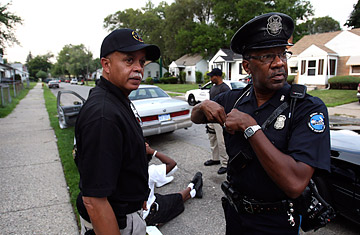
Detroit chief of police Warren Evans, left, talks with officer George Moore on patrol in Detroit
(2 of 3)
In 1970s, Evans joined the Wayne County sheriff's office, and rose quickly. After getting a law degree, he worked briefly as an assistant prosecutor, handling police shooting and drug cases. In 2003, he was appointed sheriff, a job whose main purpose is to manage the county jails.
His ascent seemed to stall last summer, when he ran for mayor against steel magnate Dave Bing and got only 10% of the vote. But last year came a shocking incident, in which seven students standing at a bus stop in one of Detroit's bleakest neighborhoods were shot, that provoked a shake-up in the police department. Bing asked his former rival Evans to become police chief, declaring, "We don't have time to wait. Our children aren't safe."
Evans quickly made his presence felt, joining beat officers patrolling Detroit's neighborhoods, often with reporters. He moved more than 100 officers from desk posts to street patrols. He broadened the mission of the SRT squads beyond hostage situations and bank robberies to bring an intimidating force to more routine police work. He also created a mobile Tactical Strike Force, which rotated about 150 officers from the department's gang squad and other units to deliver a surge of police presence in crime-tossed neighborhoods. An increase in traffic stops, police officials say, has led to the arrests of scores of people with unauthorized guns and driving without licenses.
The SRT is at the center of the current mess. Shortly after midnight on May 16, members of the SRT arrived at a two-story white house on a tree-lined street in Detroit's East Side. The officers had a warrant to search the house for a 34-year-old man believed to have shot and killed a high-school senior two days earlier. Officers claimed they announced their presence and then tossed a flash grenade through the front window of one side of the duplex to disorient the people inside. Then, police say, a 46-year-old grandmother in the front room struggled with an officer. Police say an officer's gun then discharged, fatally shooting the woman's 7-year-old granddaughter Aiyana. The death drew a broad outcry. The Rev. Al Sharpton, who spoke at Aiyana's funeral last Saturday, said her death "should be a wake-up call, not only for the authorities, but for those of us in the community who have allowed this violence and recklessness for too long."
Detroit is not the only city to go the paramilitary route. Since the 1980s drug war, experts say, many local police departments have developed such units, often with surplus U.S. military gear. Initially, the units responded to hostage situations. Increasingly, they're used proactively to search for illegal contraband, like guns and drugs, says Peter Kraska, professor of criminal justice at Eastern Kentucky University and author of Militarizing the American Criminal Justice System.
Local police have a fundamental mission: to use the minimum amount of force to bring criminals to justice. That's a very different mission from that of the military: to destroy the enemy. "When the two missions get blurred," says Tim Lynch, director of the Project on Criminal Justice at the Cato Institute, a conservative Washington think tank, it can become a recipe for excess. "When these paramilitary units are called out to execute violent raids on these homes, it's taking on the attributes of an urban war zone," he says. There's very little oversight: officers assigned to such squads often get a few days of training, with no national standards. "This is a big free-for-all," Kraska says.
